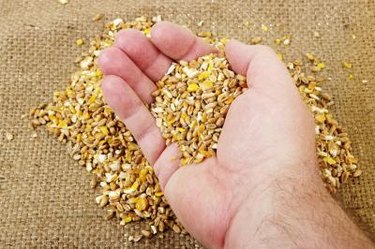
With the advent of modern farming techniques over the last 30 years or so, most farm animals are now fed grain-based diets within confined spaces, as opposed to being allowed to roam free and graze on plants and/or bugs. Feeding animals grains, such as corn, can save farmers money, space and time. However, chickens are not strictly vegetarians, so a corn diet can compromise their health and reduce the nutritional quality of their meat and eggs. Furthermore, the housing conditions of corn-fed chickens often necessitate the use of medication and additives, which also might affect the meat and eggs.
Corn-Fed Chickens
Video of the Day
Corn-fed chickens are often raised in concentrated animal farming operations, or CAFOs. Chickens in CAFOs live very close together, cannot roam freely or graze on foods that are natural for them to eat. Instead, they are fed grains, such as wheat, barley, soy, rice and corn. Corn-fed chicken are given primarily ground corn and corn cobs along with a variety of fillers and sometimes other grains. The corn used to feed chickens is rarely organic or free of genetic modification, according to "Public Health Nutrition: From Principles to Practice." In general, corn-fed chickens grow faster and bigger compared with free-ranging chickens.
Video of the Day
Dietary Needs of Chickens
Chickens, like people, are healthiest when they eat certain foods. Chickens are omnivorous, meaning they eat a variety of plants, seeds, insects and worms typically found in pastures. Corn feed provides more than enough calories, which causes the inactive chickens to bulk up quickly, but it's too low in fatty acids and certain amino acids, vitamins and minerals for chickens to thrive. Consequently, extra vitamins, minerals and amino acids are added to corn feed so that chickens can develop properly, lay eggs and mount an immune response against diseases. Still, corn-fed chickens need antibiotics and hormones in order to thwart infection and grow quickly.
Quality of Meat and Eggs
In general, grain-fed chicken meat is lower in omega-3 fatty acids, conjugated linoleic acid, magnesium, calcium and potassium compared with free-range chicken meat. Feeding chickens primarily corn produces an imbalance of omega-3 fats to omega-6 fats in their eggs. Healthy ratios should be between 1:2 and 1:4, but corn-fed chicken eggs have a ratio of up to 1:20. Omega-3 fats are important for cardiovascular health because they reduce inflammatory reactions, but too many omega-6 fats negate their benefit. Additionally, free-range eggs are often higher in vitamin E and beta-carotene.
Other Disadvantages
Corn-fed chickens are also more susceptible to being contaminated with grain pesticides, which can build-up in the fatty tissues of animals. Genetically engineered corn is commonly used in chicken feed, but any long-term health effects of eating animals raised on GMO grain are unknown. Because corn-fed chickens are typically raised in CAFOs, they are given large amounts of antibiotics to reduce infection rates, which may affect their meat and eggs in ways that are currently not understood.